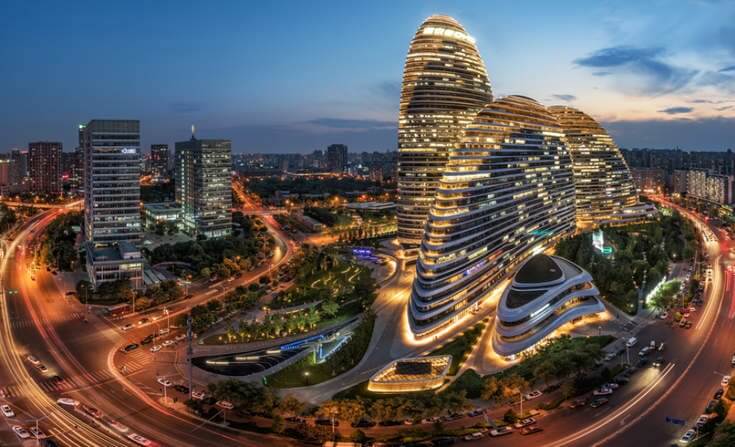The Sustainable Superpower?
5 Reasons for China's Clean Tech Boom
Lauren Hepler, GreenBiz Tuesday, July 18, 2017

Rapid urbanization, a growing appetite for middle-class consumer goods and the not-so-enviable distinction of being the world's biggest carbon polluter.
These are a few of the traits often ascribed to China in the debate about which country will pick up the mantle of climate action in a post-Paris agreement world sans U.S. leadership.
One perk of the shifting global policy landscape, according to Qi Lu, who heads research at Beijing-based clean tech investment firm Tsing Capital: a spike in international interest in China's emerging sustainable technology sector.
"We have seen more and more clean tech companies from the U.S. turning to China for its vast market," Lu said in an interview, especially after U.S. President Donald Trump signaled his intention this spring to withdraw from the Paris deal. "In this sense, we have actually seen some positive signs."
From well-known Chinese companies such as Alibaba jumping into the energy business to startups in artificial intelligence, mobility, sustainable agriculture and more, a recent Tsing Capital white paper charted just how far the country's clean tech sector has come.
China plans to invest $368 billion in high-voltage grids, smart grids and distribution grids in the next five years, in addition to a goal of getting 5 million electric vehicles on the road by 2020, the report noted. Through 2015, Bloomberg tallied more than $101 billion in annual spending on clean energy in the country.
Although Trump consistently has touted China's continued reliance on coal as one reason the United States shouldn't be beholden to emissions reduction targets, Lu said the domestic environmental conversation is increasingly driven by market and consumer demand.
“It’s not only because China has pledged to peak its CO2 emissions by 2030, but actually more and more because of public awareness," Lu said.
Here's a look behind the numbers at some of the forces driving China's clean tech ascent.
1. Clean tech grows up
Tsing Capital traces today's boom in sustainability-related technology to first-wave "envirotech" concentrated in fields such as waste water, energy efficiency, solar PV production and other policy-driven, capital-intensive businesses. In the last decade, those models evolved into more financially viable clean tech industries such as energy storage and LED lighting.
Starting in about 2012, however, Tsing has charted a new era of "sustaintech" driven by more drastic technical and economic shifts. Rather than a concentration of startups in industries reliant on government incentives, Lu said businesses with more immediate and dramatic market potential have claimed the spotlight.
"Especially in China, we’ve seen demand taking over as the new driver,” Lu said. “These companies are using intelligent technologies and also internet connections, as well as business model innovation, to disrupt the traditional clean tech landscape."
2. The remaking of manufacturing
Among the biggest factors in China's evolution as a 1.2 billion-person economic power is the country's well-known concentration of major manufacturing centers.
As foreign companies such as Apple begin to transition global suppliers to more efficient or renewably powered energy systems, Lu said manufacturing also could become a broader driver of investment in clean technologies.
"China also sees development of sustainable industries as a good opportunity to upgrade its manufacturing, and switch the country from resource intensive and labor intensive economy to an innovation-driven economy," she said.
3. Chinese corporates eye the energy business
Increasing corporate investment in renewable power is an increasingly prominent variable in the U.S. energy market.
In China, large companies such as Alibaba and Huawei are also betting big on technologies such as green data centers and the Internet of Things.
"The private sector companies are aggressively stepping into the sustainability categories," Lu said. "They're not only installing solar PV on their rooftops, but they're also expanding their business to sustainability-related business or actually starting new businesses."
4. AI, IoT connect the dots
Although industries ranging from transportation to food are part of the fold in sustainable technology, Tsing Capital credits two "megatrends" with driving underlying disruption: Internet of Things connectivity for a range of devices and the evolution of machine learning and artificial intelligence.
"Thinking about it from a sustainable development point of view, with all of the data we gather from the Internet of Things and the analyzing capability developed by machine learning and artificial intelligence, we are actually for the first time able to manage energy and resource use at a very high level," Lu said.
Among the other markets where she expects to see a significant uptick in investment activity in China and beyond: materials science being reshaped by business trends such as waste-minimizing circular economy strategies.
"Advanced materials will be a $16 trillion market by the year 2015," Lu said. "It’s the largest market trigger."
5. Eye on the bottom line
Although shifting international climate policy is one variable impacting companies and investors worldwide, Lu said her colleagues at Tsing Capital are more focused on downward cost curves in fields such as renewable power generation and storage.
How those pricing trends play out will be one key to unlocking a "waste-free, energy-efficient" future in China and beyond, Lu said.
"Clean energy is already making a very good use case and economic case," she said.
Links
GreenBiz: The sustainable superpower? 5 reasons for China's clean tech boom
GreenBiz 350 Podcast: China's clean tech ascent and that Salesforce tower


